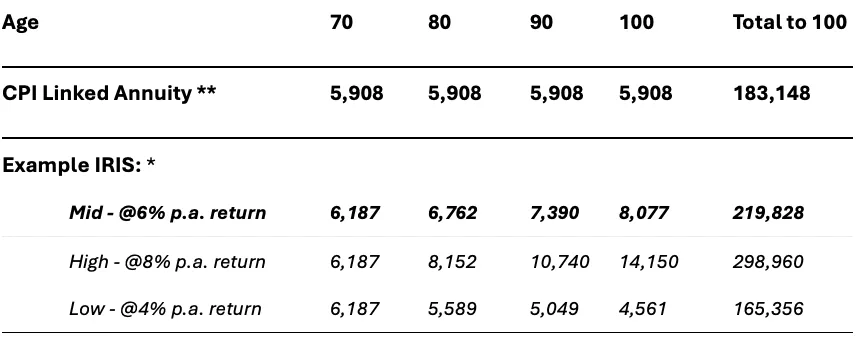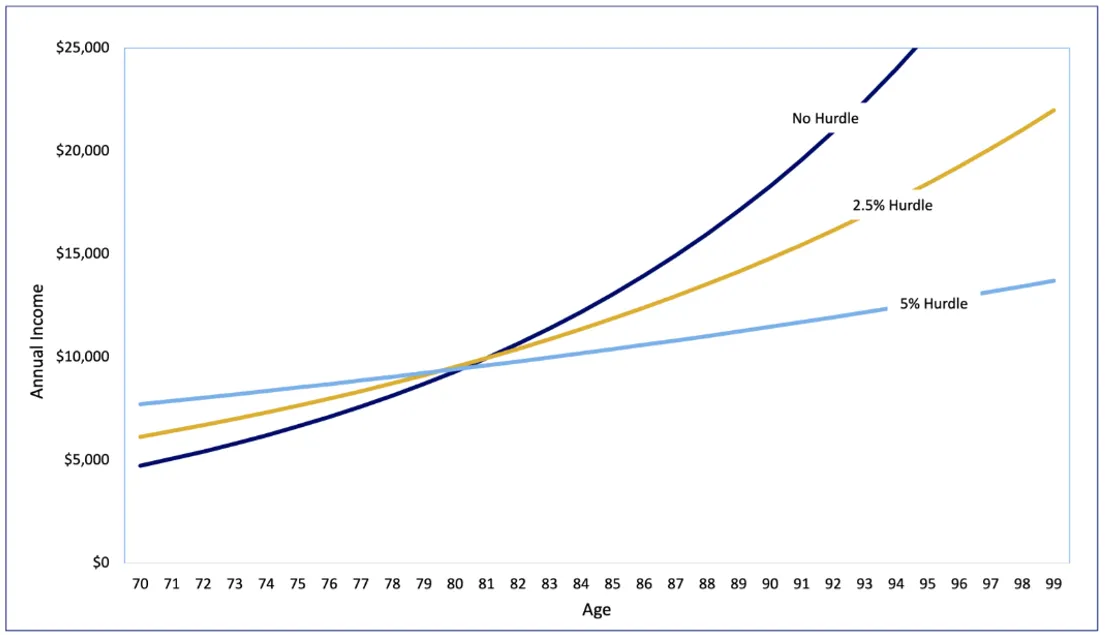Actuarial careers
Industry topics

Claim your CPD points
CPI-linked lifetime annuities offer predictable, inflation-protected retirement income for life.
In 2017, a new category of retirement income products was introduced into the Superannuation Industry (Supervision) Act, known as Innovative Retirement Income Streams (IRIS). These rules were introduced to allow longevity products that have the potential to provide consumers with higher income, greater flexibility, and the ability to participate in investment markets — all while delivering income that cannot run out.
To answer this question, let’s look at a 70-year-old retiree who is looking at two different lifetime income products. Both options are based on the same lump sum investment of $100,000. The retiree must weigh the benefits of security and simplicity from the guaranteed CPI-linked annuity against flexibility and potential upside (or downside) from the IRIS.
Just as we wouldn’t expect a bank account and a share portfolio to deliver the same results — because they serve different purposes and have different risk profiles — comparing lifetime income products is about understanding the trade-offs between security and potential returns.
A snapshot of the results (in today's dollars) is set out in the table below:

Snapshot of comparative incomes (per annum) in today’s dollars.
* Assumed returns are net of product fees and levies. The assumed IRIS also has a 2.5% hurdle rate
** Assumes CPI inflation of 2.5% p.a.
Most readers will be familiar with CPI-linked annuities. The income starts at a particular dollar amount per year and increases with inflation each year as reflected in the Consumer Price Index or CPI, providing regular, stable purchasing power for life. The insurer offering the annuity takes on the investment risk, inflation risk and longevity risk.
For retirees, CPI-linked lifetime annuities are typically considered as a secure, guaranteed, inflation-linked income.
To meet the lifetime obligations – which may extend for 40 years or more per customer - insurers must use careful actuarial assumptions and hold sufficient capital, including shareholders’ funds, to back the guarantees.
The CPI-linked annuity option in our example uses a $100,000 investment that will pay a starting income of $5,908 per annum [1] . The amount rises each year in line with increases in the Consumer Price Index. It offers unmatched certainty but no exposure to investment markets.
There is a range of different IRIS products now available in Australia [2] . Unlike CPI-linked annuities, an IRIS can unbundle the longevity insurance from the investment-guarantees. This allows products to be created that deliver lifetime income but still participate in market performance.
A typical IRIS works as follows: at commencement, the retiree’s lump sum investment is converted into an income stream. The income level gets increased (or decreased) each year based on the performance of an underlying investment portfolio, which is usually one or a number of investment options – as might be offered under an Account Based Pension or ABP. Just like an ABP, some IRIS products allow switching between these investment options. In fact, an IRIS can potentially be described as an ABP with longevity protection.
The exact mechanics for how income levels adjust are defined in the product rules and will be set out in the Product Disclosure Statement.
The starting income is determined using actuarial factors based on the retiree’s age and life expectancy as well as a common feature known as the “hurdle rate”.
The chosen hurdle rate plays a crucial role in how most IRIS products operate. Chart 1 shows how a higher hurdle rate means a higher starting income level, but future income will rise more slowly thereafter.
Chart 1: Investment-linked IRIS – Income shapes for different hurdle rate options

Chart 1: Investment-linked IRIS – Income shapes for different hurdle rate options.
Source: ‘Comparing Lifetime Income Products Using Rates’, Retirement Edge April 2025 - www.retirementedge.com.au/lifetime-income-rates-report
Importantly, the hurdle rate is not a fee. It’s a way of bringing forward some of the future expected income to enjoy higher income at the start of retirement.
For this example, we will use an investment-linked annuity as the IRIS. Our retiree is considering a 2.5% hurdle rate. It pays a starting annual income of $6,187 [3] . Each year, the income is increased (or decreased) based on the net investment performance of the customer’s chosen investment option over and above 2.5%.
How do outcomes compare over time?
In Chart 2, we show a projection of income from the CPI-linked annuity and the IRIS. It assumes inflation is 2.5% p.a. For the projected income from the IRIS, this depends on what investment returns are (net of fees). We show three examples using fixed net returns of 4% p.a., 6% p.a. and 8% p.a.
Chart 2: Income Over Time – CPI-linked Annuity vs IRIS

Chart 2: Income Over Time – CPI-linked Annuity vs IRIS (figures are in nominal dollars)
In the first year, the IRIS product offers around 4% more income than the CPI-linked annuity.
If we assume 6% p.a. net returns then over time the IRIS income grows at roughly 3.5% per year (6% return less the 2.5% hurdle), which exceeds inflation and results in an increasing real income.
By age 80, the 6% p.a. return scenario sees the IRIS paying annual income of $8,656, while the CPI-linked annuity would have grown to around $7,563 if inflation is 2.5% p.a. That’s a 14% income gap in favour of the IRIS product, and the difference widens as time progresses but is subject to actual investment performance of the chosen IRIS.
In reality investment markets don't deliver constant year by year returns like this. Actual market returns vary each year and are subject to risk. The 4% net return projection and 8% net return projection demonstrate basic sensitivities around the above projections.
To give an example, SuperGuide publish median year-by-year return for Growth funds (61-80% allocation to growth assets) [4] . Over the 30 years to December 2024, an investor receiving the median return would have achieved a compounded return of 7.6% p.a. net of investment fees and tax (although their returns varied from year to year). Over the same period, CPI inflation averaged 2.7% p.a. meaning a real return of approximately 4.9% p.a. Notably, the median Growth fund recorded a negative return in only four of the 30 calendar years.
It can be helpful to use ‘full spectrum’ modelling (known as stochastic modelling) to stress test the full range of likely return sequences and member outcomes after fees and the hurdle rate. An example of this type modelling for IRIS products was shown in the Actuaries Institute submission to the Retirement Incomes Review [5] (refer to the Appendix of that submission p26 - 28).
What’s driving the differences?
The key difference in outcome lies in how returns are distributed:
This product suits cautious or risk-averse retirees who desire guaranteed income levels that don’t fluctuate in purchasing power over time.
This option may suit retirees who are accustomed to accepting some investment risk in exchange for the potential of higher income.
Some IRIS products allow switching between the available investment options by the annuitant — for example, to get out of or into equity-based investment options when equity markets are deemed high or low, respectively. Switching investments has been a drawback for advisers with annuities in the past, as they cannot advise on the underlying asset allocation of traditional annuities, whereas now they can. Skilled financial advisers can align the investment mix within the IRIS with each client’s unique preferences, risk profile and circumstances.
Important: When designing an appropriate product mix for retirement, advisers and their clients are likely to use a combination of products rather than relying on a single product. An account-based pension would typically form a part of the mix, alongside other products that help manage longevity risk. In practice, clients may blend different products to align with their overall needs — potentially including multiple annuities, from both superannuation and non-superannuation savings.
What about downside risk?
It’s important to recognise that the IRIS income in this example can go down in years of poor returns–if net investment returns are lower than the hurdle rate. For example, if the portfolio returns only 1% in a given year, income would likely fall by 1.5% (1% minus the 2.5% hurdle).
Maximising retirement income
For a retiree today, IRIS products are a compelling addition to the income toolkit – especially for superannuation members already accustomed to investment risk. While the income may vary, IRIS products can offer:
By incorporating IRIS products into the retirement phase, superannuation funds and advisers have a valuable opportunity to design lifetime income solutions that deliver both income sustainability and growth potential. IRIS products help to support the efficient use of retirement savings, allowing members to draw higher income in the early years while mitigating longevity risk over their lifetime. They represent a scalable, sustainable, and member-aligned approach to help fulfil the Retirement Income Covenant.
[1] Based on example rates published by Challenger on 13 May 2025 for a single male.
[2] Examples include Generation Life’s LifeIncome, Challenger’s Liquid Lifetime, ART’s Lifetime Pension and AMP’s MyNorth Lifetime. Allianz Retire+ offer a similar product with an investment performance floor and cap. For a full list, see www.retirementedge.com.au/providers .
[3] Based on the Generation Life LifeIncome product with a 2.5% hurdle rate. Rates applicable as at 30 April 2025 for a single male. See the Product Disclosure Statement for full product details.
[4] https://www.superguide.com.au/comparing-super-funds/super-funds-returns-financial-year based on performance figures from Chant West.
[5] https://treasury.gov.au/sites/default/files/2020-02/actuariesinstitute040220.pdf